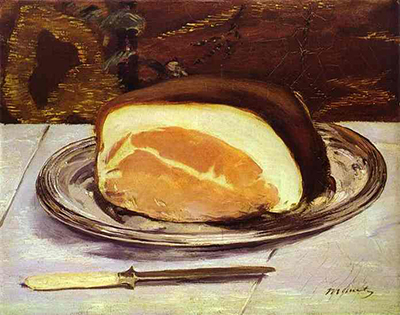Edouard Manet was born on January 23, 1832, in Paris, France, and died at the age of 51 in his home city on April 30, 1883. He left behind 430 paintings ranging from his favorite subject, people, to landscapes, still lives and flowers.
The Ham is a still life, he painted in 1880. It shows a smoked ham of approximately 60 percent meat and 40 percent fat. The ham rests on a shiny metal plate, on a table with a white table cloth. In front of the plate, horizontally, there is a knife with a white bone handle. One can only wonder why Manet painted this piece of meat. Did he have a particular fondness for smoked ham or was there a shortage of this type of food? In the background, we see what could be a curtain, in warm browns and oranges. While the skin of the ham matches the curtain perfectly, the inside meat somewhat pales by comparison. The Ham is an oil on canvas, measuring 41.2 x 16.22 inches in realism style. The painting can be seen at the Kelvingrove Art Gallery and Museum in Glasgow, United Kingdom. The painting was donated by Sir William and Lady Burrell in 1944.
Quite different is Paul Gauguin painting of ‘The Ham’. In this painting the background is a dirty orange, emphasizing the rich color of the meat. Gauguin's ham is served on a green platter on a green table. A green glass, half full with a dark liquid is positioned next to the plate along with eight onions. Another painter who had a fondness for ham was Jacob Samuel Beck. In his version, we not only see a smoked ham but numerous other foods such as a fish with half a lemon on a metal platter, a bread roll, a green bowl filled with peaches and green grapes, a bottle of wine and a few leaves of a green plant. Keeping the background black emphasizes the color of the ham and the fruit.
Anne Vallayer-Coster specialized in still lives and painted a ham on a plate that shows far more meat than fat with a knife stuck into it. The ham is positioned on a table, partially covered with a rumpled table cloth. Next to the ham, she positioned a bunch of carrots, while behind it stand two bottles. These could either be two kinds of wine, or a bottle of oil and a bottle of vinegar. Against the dark background, the painter included a branch of green leaves.




